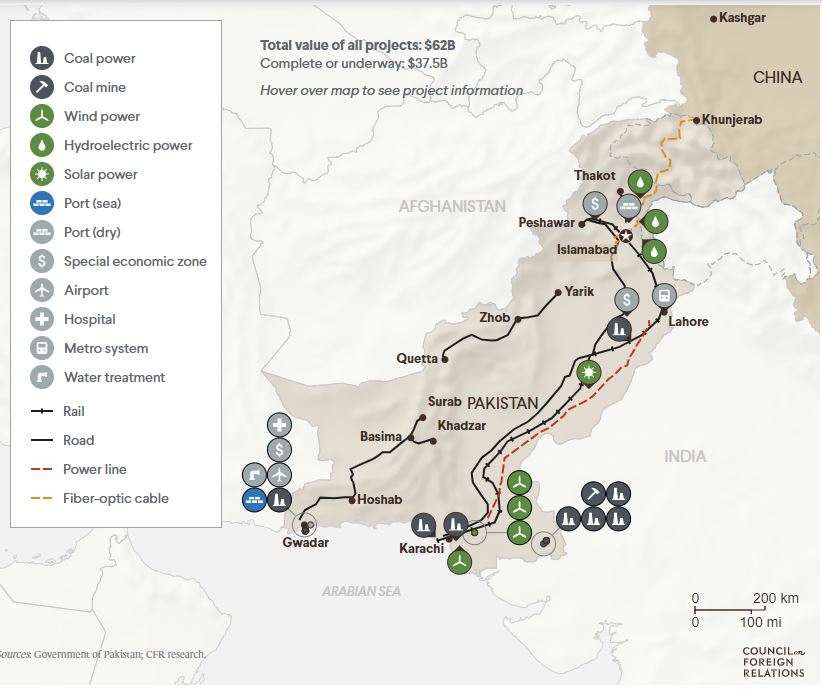 by Shaimin Raja 8 December 2023
by Shaimin Raja 8 December 2023
In the intricate web of global geopolitics, the China-Pakistan Economic Corridor (CPEC) emerges as a symbol of an evolving alliance between two nations—China and Pakistan. This ambitious venture, conceived under the expansive umbrella of the Belt and Road Initiative (BRI), transcends mere economic collaboration; it paints a portrait of shared goals, mutual interests, and the transformative potential of strategic partnerships.
Economic Symphony: A Harmonious Investment
At the heart of CPEC lies a vision—an intricate network of roads, railways, pipelines, and energy infrastructure seamlessly linking China’s western region to Pakistan’s Gwadar Port. Positioned as the “flagship project” of the BRI, this corridor not only navigates around maritime chokepoints but also establishes novel trade and connectivity channels. The result? A reduction in transportation costs for China and augmented access to vital energy resources.
The economic bonds forged through CPEC are profound. The multi-billion-dollar investment has breathed new life into Pakistan’s infrastructure, energy sector, and industries. From power plants to highways and the Gwadar Port, these ventures have not only spurred economic growth but have also been instrumental in generating employment opportunities. Chinese investments have played a pivotal role in alleviating Pakistan’s energy shortages and steering economic diversification.
Yet, in the pursuit of economic prosperity, CPEC has encountered its fair share of challenges. Security concerns along the corridor, transparency issues, and anxieties about debt sustainability have cast shadows on its trajectory. Critics argue that CPEC might burden Pakistan with unsustainable debt, though both nations have taken steps to address these apprehensions. Nevertheless, CPEC remains a substantial opportunity for Pakistan to modernize its infrastructure and harness China’s technological expertise.
Beyond Borders: Regional Integration and Global Standing
CPEC, extending its influence beyond bilateral dynamics, serves as a catalyst for regional integration. It aspires to position Pakistan as a pivotal trade hub linking Central Asia, the Middle East, and Africa. Neighboring countries, including Iran and Afghanistan, have expressed interest in joining this transformative initiative. Such enthusiasm underscores CPEC’s potential to reshape not only national but regional economic landscapes.
Geopolitically, CPEC has rewritten narratives in South Asia, enhancing Pakistan’s regional standing by solidifying its role in connecting China to global markets. This newfound significance carries profound implications for Pakistan’s foreign policy and its relations with other regional players. Moreover, CPEC presents an alternative narrative to traditional Western-led development models, emphasizing connectivity and development projects.
A Symphony of Collaboration: Shared Goals and Mutual Aspirations
At its core, CPEC reflects shared goals and mutual interests between China and Pakistan. Aligned with both countries’ economic development strategies, the project complements China’s vision of creating a more connected world. China’s substantial investment in Pakistan’s future underscores the depth of their partnership and shared aspirations. As Prime Minister Kakar aptly encapsulated, “CPEC is not just a project but a means to bring about a comprehensive change.”
Beyond the realm of infrastructure, CPEC has facilitated and enhanced diplomatic ties. It has fostered regular interactions between Chinese and Pakistani officials, leading to deeper cultural exchanges and people-to-people contacts. Such endeavors promote greater understanding and goodwill between the two nations, laying the groundwork for a robust diplomatic relationship.
Challenges as Opportunities: Collaborative Solutions
Despite the challenges encountered along CPEC’s journey, the initiative presents an opportunity for China and Pakistan to collaborate and find innovative solutions. Joint efforts in addressing security concerns, ensuring transparency, and managing debt exemplify the resilience of their partnership. As former Pakistani Foreign Minister Shah Mehmood Qureshi wisely noted, “CPEC is not only about connectivity but a complete package for economic development. It is a way forward for both countries to overcome economic challenges.”
Conclusion: A Pivotal Chapter Unfolding
In conclusion, the China-Pakistan Economic Corridor signifies a pivotal chapter in the bilateral relations between the two nations. Beyond its infrastructural and economic benefits, CPEC embodies a shared vision of prosperity, connectivity, and development. It has fostered strategic cooperation, reshaped geopolitical dynamics, and paved the way for stronger diplomatic ties.
As the journey of CPEC unfolds, the collaborative efforts of China and Pakistan stand as a testament to the enduring strength of their partnership and the transformative potential of economic initiatives in shaping global relations. In the symphony of international relations, CPEC plays a distinctive tune—one that resonates with collaboration, mutual growth, and a shared journey towards a connected and prosperous future.
